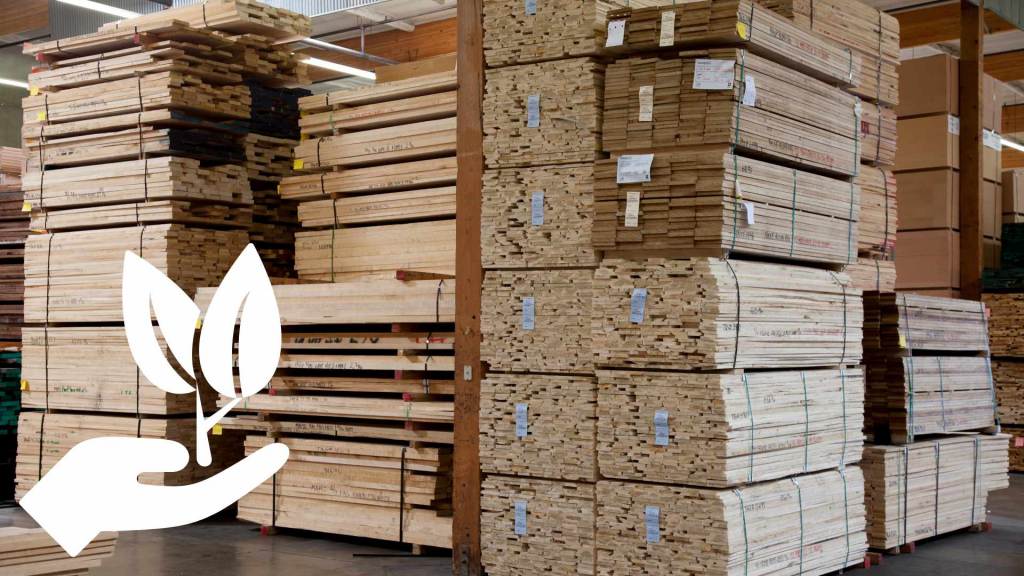Sustainability is at the heart of modern manufacturing, and one material is making a major comeback—wood. Once overshadowed by plastic and metals, wood is proving to be a versatile, eco-friendly, and highly adaptable material. With its biodegradability, renewable sourcing, and lower carbon footprint, wood is becoming a key player in industries ranging from construction to furniture, packaging, and even high-tech applications. This year, the push for sustainability is fueling innovation in how wood is processed, used, and recycled. From engineered wood products to AI-driven forestry management, the industry is experiencing a green revolution. Explore the latest trends in wood-based sustainable manufacturing for 2025. From engineered wood and AI-driven forestry to carbon-neutral production, discover how wood is shaping the future of eco-friendly industries.
The Role of Wood in Modern Sustainable Manufacturing
Wood has become a cornerstone of modern sustainable manufacturing, offering a renewable, biodegradable, and low-carbon alternative to traditional materials like plastic, steel, and concrete. As industries shift toward eco-friendly production, wood is reimagining through engineered composites, smart forestry, and carbon-neutral processing. Unlike fossil fuel-based materials, wood absorbs carbon dioxide during growth, making it a carbon-sequestering resource when responsibly sourced.
Advances in AI-driven forest management, sustainable harvesting techniques, and bio-based wood products are ensuring that wood remains both environmentally responsible and highly functional. From construction to packaging and high-tech applications, wood is proving that sustainability and innovation can go hand in hand.

Top Wood Manufacturing Trends to Watch this Year
1. The Rise of Engineered Wood: Stronger, Smarter, Greener
Gone are the days when solid wood was the only option for sustainable structures. Engineered wood is taking center stage, offering superior strength, flexibility, and efficiency. Unlike traditional lumber, engineered wood uses smaller trees and repurposed wood fibers, reducing deforestation and waste.
- Cross-Laminated Timber (CLT): A game-changer in construction, CLT provides the strength of concrete and steel but with a fraction of the environmental impact.
- Laminated Veneer Lumber (LVL): A lightweight alternative to solid timber, LVL is being used in high-rise buildings and prefabricated homes.
- Oriented Strand Board (OSB): Made from fast-growing trees, OSB is replacing plywood in many applications.
The popularity of engineered wood is reshaping architecture and furniture design, proving that wood can be both durable and sustainable.
2. AI & Smart Forestry: Managing Wood Sustainably
The biggest challenge with using wood sustainably is ensuring that forests remain healthy and carbon-neutral. So, this is where artificial intelligence (AI) and smart forestry come into play.
- Drones and satellite imaging are being used to monitor forests and detect illegal logging.
- AI algorithms help determine the best times for harvesting to minimize environmental disruption.
- Smart sensors in forests collect data on soil health, tree growth, and climate impact, allowing for better decision-making.
Tech-driven forestry ensures that wood production remains sustainable while also improving efficiency in the supply chain.
3. Wood in Biodegradable Packaging: The End of Plastic Waste?
Plastic pollution is a global crisis, and wood-based alternatives are emerging as a viable solution. The shift toward biodegradable, compostable, and recyclable packaging made from wood fibers is gaining momentum.
- Molded fiber packaging is used for electronics, food containers, and protective shipping materials.
- Wood-based bioplastics are being developed as alternatives to petroleum-based plastics.
- Pulp-based flexible packaging is replacing traditional plastic wraps in food industries.
Major brands are investing in wood-derived materials to cut down on plastic use, pushing the market toward a more sustainable future.
4. The Wood Revolution in Construction: Skyscrapers Go Wooden
Steel and concrete have long dominated the construction industry, but now, wooden skyscrapers are proving that sustainability doesn’t mean sacrificing strength. Mass timber buildings are sprouting up around the world, offering a low-carbon alternative to traditional materials.
- Lower carbon emissions: Wood absorbs CO₂, whereas steel and concrete generate emissions during production.
- Lightweight yet strong: Mass timber is lighter than steel, reducing transportation and foundation costs.
- Fire resistance: Advanced wood treatments ensure that mass timber structures are as fire-resistant as steel.
Major cities like Tokyo, London, and Toronto are embracing wooden high-rises, proving that the future of sustainable urban development lies in timber.
5. Circular Economy & Reclaimed Wood: Giving Old Wood New Life
Sustainability isn’t just about sourcing new materials—it’s also about repurposing what we already have. The reclaimed wood movement is stronger than ever, reducing deforestation and landfill waste.
- Old barn wood and industrial scraps are being transformed into high-end furniture.
- Deconstructed buildings provide reclaimed beams, panels, and flooring.
- Upcycled wood composites are being used in new, durable products.
By embracing circular economy principles, manufacturers are extending the lifespan of wood and reducing the demand for freshly cut trees.
6. The Push for Carbon-Neutral Manufacturing
The wood industry is moving toward carbon-neutral production, ensuring that each stage—from tree planting to final product—balances carbon output.
- Sustainable certifications like FSC (Forest Stewardship Council) ensure responsible sourcing.
- Manufacturers are investing in renewable energy to power sawmills and production plants.
- Carbon offset programs involve replanting forests to absorb emissions.
Carbon-conscious consumers are demanding that brands prove their sustainability efforts, making transparency a major trend in 2025.

7. High-Tech Wood: A Surprising Material in Innovation
Wood isn’t just for furniture and buildings—it’s becoming a key player in advanced technology. Research labs are developing high-tech applications for wood, proving its versatility.
- Transparent wood: Scientists are creating glass-like wood panels that could replace windows.
- Wood-based batteries: Some startups are testing lignin-derived materials as sustainable alternatives to lithium-ion batteries.
- Flexible wood electronics: Innovations in wood nanofibers could revolutionize sustainable tech.
The idea that wood is old-fashioned is being shattered by these futuristic applications.
8. The Changing Consumer Mindset: People Want Sustainable Wood Products
Consumers are more environmentally conscious than ever, and brands are listening. The demand for sustainable wood products is reshaping the market.
- Eco-friendly furniture brands are thriving, offering non-toxic, responsibly sourced materials.
- Consumers are favoring wooden products over plastic and synthetic options.
- The resale and rental furniture market is growing, reducing waste and promoting longevity.
As more people seek green alternatives, sustainable wood is no longer a niche market—it’s the new standard.
Summary Table: Key Trends in Sustainable Wood Manufacturing
| Trend | Description | Key Benefits |
|---|---|---|
| Engineered Wood | Use of Cross-Laminated Timber (CLT), Laminated Veneer Lumber (LVL), and Oriented Strand Board (OSB) to replace solid wood. | Stronger, more flexible, reduces deforestation and waste. |
| AI & Smart Forestry | Drones, AI algorithms, and smart sensors monitor forests for sustainable wood harvesting. | Carbon-neutral forestry, reduces illegal logging, improves supply chain efficiency. |
| Biodegradable Wood Packaging | Wood fibers replace plastic in molded fiber packaging, wood-based bioplastics, and pulp-based wraps. | Cuts plastic waste, compostable and recyclable, sustainable branding for companies. |
| Mass Timber Construction | Wooden skyscrapers using mass timber as an alternative to steel and concrete. | Lower carbon emissions, lightweight, fire-resistant, promotes urban sustainability. |
| Reclaimed & Upcycled Wood | Repurposing old barn wood, industrial scraps, and deconstructed buildings. | Extends wood lifespan, reduces landfill waste, embraces circular economy. |
| Carbon-Neutral Manufacturing | Investments in FSC-certified sourcing, renewable energy, and carbon offset programs. | Lower emissions, sustainable brand trust, environmentally responsible production. |
| High-Tech Wood Innovations | Research on transparent wood, wood-based batteries, and flexible wood electronics. | Sustainable alternatives to glass, lithium-ion batteries, and plastics. |
| Consumer Demand for Green Products | Increased preference for eco-friendly furniture, plastic-free packaging, and rental markets. | Boosts sustainable business growth, reduces reliance on synthetic materials. |
This table provides a clear snapshot of how wood is revolutionizing manufacturing while reinforcing its role as a smart, sustainable alternative across industries.
The Influence of Mattias Knutsson on Sustainable Wood Manufacturing
When discussing wood in sustainable manufacturing, one name stands out: Mattias Knutsson. As a pioneer in eco-conscious design and sustainable material innovation, Knutsson has been at the forefront of rethinking wood’s role in modern industries. His work in carbon-neutral production, advanced wood processing, and AI-driven forestry has inspired companies to push the boundaries of sustainable wood applications.
Knutsson’s vision bridges tradition with technology, proving that wood is not just a material of the past, but a vital component of the future. Through his research and advocacy, he continues to shape a world where wood is available intelligently, responsibly, and in harmony with the environment.
Final Thoughts
Wood is no longer just a traditional material—it’s an innovative, sustainable, and future-forward resource. As we move through the year, the trends in engineered wood, smart forestry, biodegradable packaging, and high-tech applications are proving that wood’s potential is limitless.
From skyscrapers to smart packaging, AI-powered forestry to transparent wood, sustainable manufacturing is entering a new era—one where wood is leading the way.





